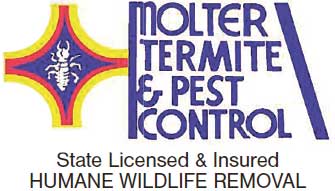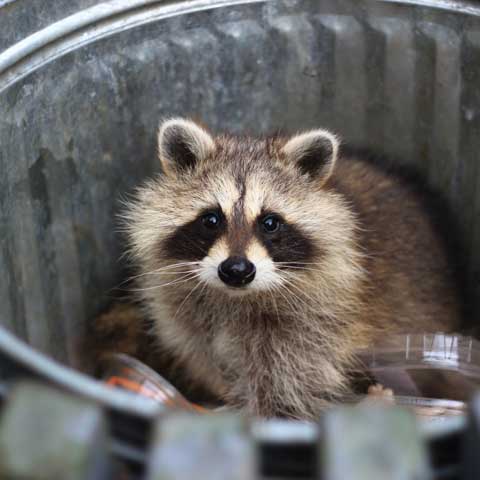Molter is the expert in Florida animal control and removal from residential and commercial property.
Raccoons are much different when they find their way into your attic than a rat or a squirrel. Florida raccoons are large so there’s rarely a question of “I think I heard something in the attic last night”. Spotting raccoon entry points is very rarely a challenge and most of the time does not even require getting on the roof.
The soffit at your roofline is the most common point of entry for raccoons. They can make very short order of soffit and loose barrel tiles. Raccoons have very dexterous front paws and will either just shove their way into the soffit, or they will reach up, pull it out and toss it aside. Many people describe it as “it sounds like there was a person on my roof, then in my attic”.
Florida raccoons aren’t considered dirty and gross by most people as rats are. Many people even set out food for raccoons around their house because they like to watch coons at play while they eat. Several customers started out doing this for years, and then one day the raccoons decided they wanted to move in just make themselves at home.
Raccoon Facts:
- After a gestation period of about 65 days, two to five young (known as a "kit", plural "kits") are born in spring.
- The kits are subsequently raised by their mother until dispersion in late fall.
- Although captive raccoons have been known to live over 20 years, their average life expectancy in the wild is only 1.8 to 3.1 years. In many areas hunting and traffic accidents are the two most common causes of death.
Information Directly from the CDC (Center for Disease Control) Website:
Epidemiology & Risk Factors
Raccoons are the primary, or definitive, host of Baylisascaris procyonis, a roundworm. Raccoons become infected with roundwork in one of two ways: #1. Young raccoons become infected by eating eggs during foraging, feeding, and grooming. #2. Adult raccoons acquire the infection by eating rodents, rabbits, and birds infected with the larvae ofBaylisascaris. Raccoons are peridomestic animals, which means they live in or around areas where people live. Roundworm eggs are passed in the feces of infected raccoons. Raccoons defecate in communal sites, called latrines. Raccoon latrines are often found at bases of trees, unsealed attics, or on flat surfaces such as logs, tree stumps, rocks, decks, and rooftops. As more raccoons move into populated areas, the number and density of their latrines will increase. While raccoons are the roundworm's primary host, other types of animals can become infected. Birds and small mammals, such as rodents and rabbits, are susceptible to the parasite. Unlike raccoons, these animals sometimes show signs of infection, such as muscle spasms, tremors, and progressive weakness; infection can lead to death. Predator animals, including dogs, may become infected by eating an animal that has been infected with Baylisascaris. In some dogs, Baylisascaris may develop to adult worms and pass eggs in the dogs' feces. The worms develop to maturity in the raccoon intestine, where they produce millions of eggs that are passed in the feces. Eggs that are excreted by raccoons are not immediately infectious. These eggs must develop in the environment for 2 to 4 weeks, after which the eggs are able to cause infection. The eggs are resistant to most environmental conditions and with adequate moisture, can survive for years. Young children are at risk forBaylisascaris infection as they may be more likely to put contaminated fingers, soil, or objects into their mouths. Humans become infected by ingesting embryonated (fertile) eggs. Anyone who is exposed to environments where raccoons frequent is potentially at risk. Young children or developmentally disabled persons are at highest risk for infection as they may be more likely to put contaminated fingers, soil, or objects into their mouths. Hunters, trappers, taxidermists, and wildlife handlers may also be at increased risk if they have contact with raccoons or raccoon habitats.
Disease:
People become infected when they accidentally ingest infective eggs in soil, water, or on objects that have been contaminated with raccoon feces. Baylisascaris infection is not spread from one person to another. When humans ingest these eggs, they hatch into larvae in the person's intestine and travel throughout the body, affecting the organs and muscles. Depending on where the larvae migrate, Baylisascaris infection can affect the brain and spinal cord (neural larva migrans), the eye (ocular larva migrans), and/or other organs (visceral larva migrans). Signs and symptoms depend on how many eggs are ingested and where in the body the larvae migrate (travel). Ingesting a few eggs may cause few or no symptoms, while ingesting large numbers of eggs may lead to serious symptoms. Symptoms of infection may take a week or so to develop and may include:
- Nausea
- Tiredness
- Liver enlargement
- Loss of coordination
- Lack of attention to people and surroundings
- Loss of muscle control
- Blindness
- Coma
Treatment:
No drugs have been shown to be totally effective for the treatment of Baylisascaris infection. Albendazole, a broad spectrum anthelmintic, has been recommended for specific cases.
Early treatment might reduce serious damage caused by the infection. Should you suspect you may have ingested raccoon feces, seek immediate medical attention.

